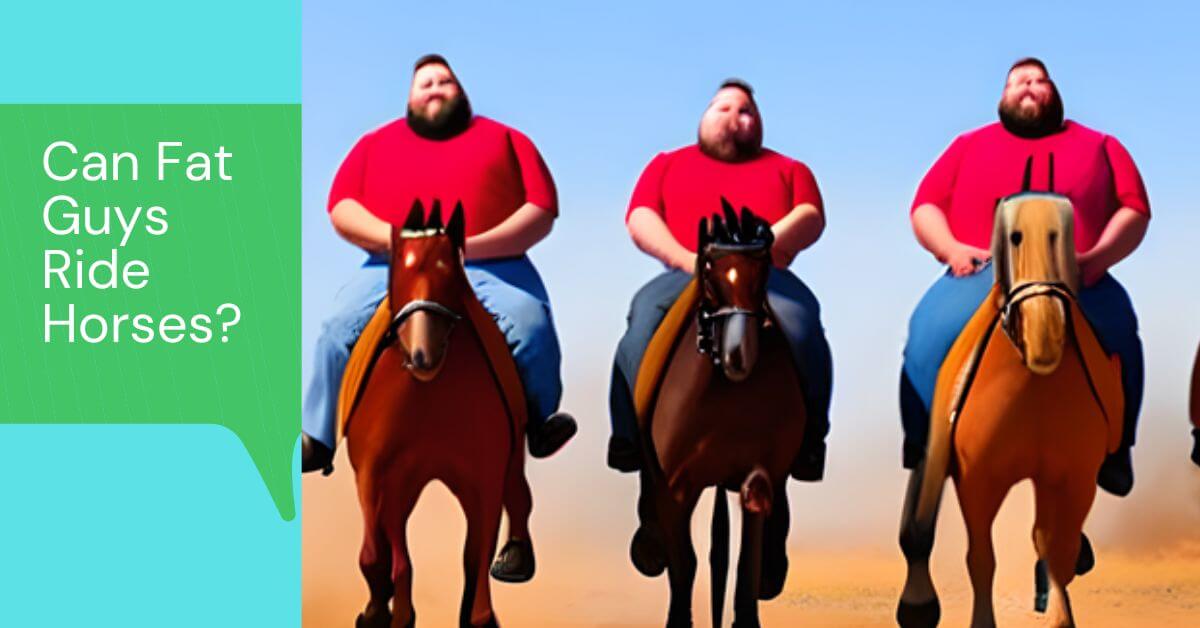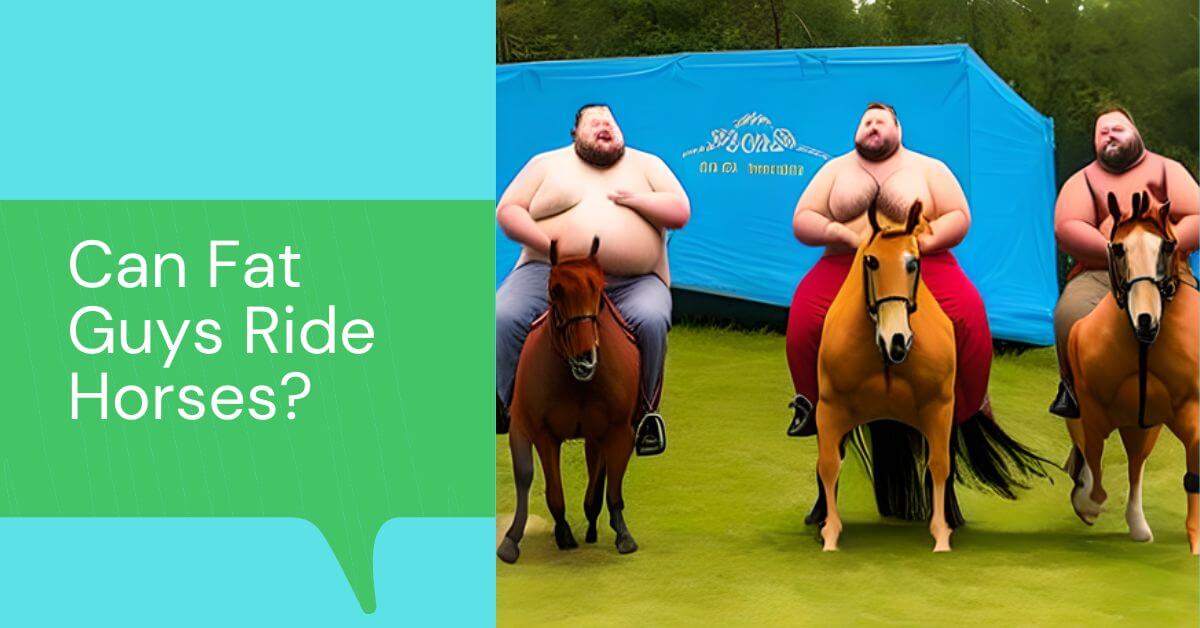Are you interested in riding horses but concerned about your weight? Wondering if having a few extra pounds will safeguard your horse riding experience? If so, this article is for you.
Riding a horse can be an exciting and engaging experience, no matter what your size. All riders regardless of their body type benefit from the pleasure and freedom, while sitting on top of a horse. But even though all sizes are welcome in the world of horseback riding, there are certain safety concerns that overweight riders need to be aware of while mounting or dismounting.
In spite of the hazards that come with being an overweight horse rider, it is still possible for fat guys to have an enjoyable time on a horse’s back. In this article, we will explore the advantages and disadvantages for fat guys who want to take up equestrianism; with some effective tips from experienced trainers and instructors on how to stay safe when riding a horse.
Can a Horse Carry a 200-Pound Person?
Yes, a horse can carry a 200-pound person, depending on the breed and size of the horse as well as its overall health and fitness level. Most horses are capable of safely carrying riders up to 15% of their body weight, which means a 1,000 lb horse (450 kg) should be able to handle an additional 150 lbs (68 kg).
However, some larger horses may be able to handle more weight depending on their fitness and strength level. Many experienced riders suggest that the ideal riding weight is around 10-12% of the horse’s body weight. It is important to always consult with your veterinarian before allowing someone to ride a horse, especially if they are significantly heavier than average.
Factors to Consider When Choosing a Horse for a Larger Person
The size of the horse is important when picking a mount for a larger person, since a small horse may not have the strength or endurance to carry extra weight. Look for horses that are at least 15 hands or taller as this provides additional support for the heavy rider.
Take into account the horse’s level of skill and training as well when making your selection. A less experienced horse may be more challenging to handle so it is best to start with one that has some riding experience under its belt and is familiar with basic commands such as walking, trotting, and cantering in order to guarantee a safe ride.
Choose a horse with an even temperament since larger people can easily spook or upset anxious animals with their added size or weight. Opt for breeds that have good dispositions such as Quarter Horses, Anglo-Arabians, Draft Horses, Andalusians, or any crossbreeds of these types of horses that have been specifically bred as companion animals rather than racehorses due to their steadiness and easygoing mannerism.
Look out for sound conformation in your chosen breed in order to guarantee correct balance between its structure and body compositions using external characteristics along the neck, back, and legs which will ensure efficient movement without too much strain on either side when carrying extra weight over long periods of time
Consider a horse’s age and how this might affect its usability with larger riders since mature horses may not be able to bear more burden than younger ones due to wear from years of use. choose an animal four years old or younger where possible in order to get more mileage from your mount without putting too much strain on it over time due to excessive weight loadings onto an older equine’s bones

The Importance of Being Weighed Properly When Attempting Horse Riding as an Overweight Person
When attempting horse riding as an overweight person, it is of utmost importance to be weighed properly. Since horses are able to carry a maximum load, an overweight person’s weight must accurately reflect that which the horse can safely and comfortably handle in order to ensure a safe and enjoyable ride.
Being weighed accurately also ensures that the saddle fits properly, minimizing the chances of slipping or pain during the ride. Furthermore, since more weight means more strain on the legs of a horse, it is essential for their muscles and joints to be appropriately supported by the correct distribution of weight between the seat and stirrups.
Finally, understanding one’s own limits helps avoid putting too much strain on both rider and horse; anything from poor posture to improper balance can lead to too much distress being placed on either if they are ridden while being overweight. Therefore weighing correctly is a critical factor when preparing for a ride around as a heavier person.
Protective Equipment Necessary for Safe Riding
DOT/SNELL/ECE approved Motorcycle Helmet:
A helmet is the most important piece of riding gear and must meet one of the applicable safety standards; whether that be SNELL, ECE, or DOT in order to ensure it will provide adequate protection in case of a crash or any kind of accident.
Eye protection:
Clear, shatterproof glasses or goggles can protect your eyes from wind, dust, dirt, and debris while riding, ensuring visibility on the roads at all times and preventing eye irritation or injury, especially when traveling at highway speeds.
Riding Jacket & Pants:
A good quality leather or textile jacket should be chosen to suit all types of weather conditions and temperatures – providing warmth in cold weather and comfort with breathable materials during hot days. Additionally, wearing dedicated protective pants will add an extra layer of abrasion resistance against sliding down the road if you ever experience an accident.
Gloves:
Gloves are essential for providing extra grip on handlebars as well as protecting hands from any sharp objects on the road that may cause cuts. The material (usually full-grain cowhide leather) also adds an added level of abrasion resistance should you experience a spill during your ride so make sure to find a pair with reinforced knuckles for proper protection and a snug fit for better control over bike movements.
Boots:
Wearing dedicated motorcycle boots will offer extra ankle support while controlling the motorcycle along with increased protection compared to regular footwear thanks to stiffer soles and reinforced toes; preventing any loosened shoes from getting caught up in moving parts underneath your vehicle’s footpegs while riding which could lead to serious injury or loss of control over bike movements.
Tips and Tricks for the Bigger Rider While Riding the Horse
Get to know the horse. Before taking the reins, spend some time getting to know the horse’s individual personality and mannerisms. Ask questions such as what can he do comfortably? What is his limit? Doing so will help you determine which riding style and techniques work best for him.
Warm up before mounting. Give the horse plenty of time to warm up and stretch out his legs prior to hopping into the saddle. This allows the animal’s muscles and tendons to become loose in order for him to perform better during a ride.
Engage your core muscles. For larger riders, it is very important to engage your core muscles when riding a horse in order to provide support for your upper body and maintain balance better than if you weren’t engaged at all or only halfway engaged in your core muscles when riding.
Sit tall and balanced on the horse’s back by spreading your weight evenly between both legs and shifting as needed while riding in different directions, such as circles around an arena or across terrain on a trail ride. This position will keep you centered with control over any movement wasted from side-to-side or front-to-back instability created from lack of posture awareness and correct body placement on the horse’s back.
Make sure that all of your contact points are secure (elevators, stirrups, reins, etc.). When starting out a ride make sure that everything has been set up correctly so everything remains secure throughout each move for example transition from trotting to cantering/galloping or halting abruptly after spending extended periods of time at higher speeds going through several changes of direction etcetera).
Move with the horse’s rhythm rather than trying to impose your own gait onto it; this helps create a more harmonous dialogue between rider and mount that prevents abruptness with movements behind them – remember they may not be expecting any specific action right away causing confusion when it comes suddenly!
Adjusting accordingly increases safety levels significantly – especially those considered high at faster speeds like cantering/galloping together shortening strides into corners while still remaining balanced enough upright with control!
Related Post: Can Fat Guys Wear Cowboy Boots
Training Methods And Diet Programs That Can Help Fat Guys Succeed In Horseback Riding
Training Methods:
- Start with shorter rides to work on building endurance and strength.
- Focus on core muscles and developing a strong base of core strength to help keep you balanced while riding.
- Increase the duration of your rides gradually as you become conditioned for more intense rides and more complex maneuvers, such as cantering and jumping.
- Practice proper form when going through exercises that are helpful for horseback riding, including squats, lunges, planks, burpees, crunches, and push-ups.
- Strengthen the muscles in your legs to get better control over your horse’s movements by using a resistance band or doing calf raises with weights or yoga poses such as chair poses and mountain climbers.
- Work on improving cardiovascular fitness so that you have enough stamina to sustain long rides without getting tired quickly by running or biking for 30 minutes at least three times per week or joining a spinning class twice per week.
Diet Programs:
- Incorporate healthy carbohydrates into your diet such as brown rice, quinoa, sweet potatoes and whole grains which provide sustained energy throughout the ride while reducing fatigue caused by eating unhealthy processed sugars like candy bars and soda drinks.
- Increase intake of anti-inflammatory foods such as fruits, vegetables, nuts and seeds to reduce muscle soreness that comes with riding horses often; omega-3 fatty acids found in salmon are also great natural sources of inflammation-fighting properties and can help protect against joint stiffness when riding horses regularly too!
- Drink plenty of water throughout the day – hydration is key for any form of physical activity but is especially important in horseback riding where dehydration can lead to dizziness or even fainting due to the strenuous nature of horseback riding activities!
Final Verdict
In conclusion, it is clear that even fat guys can ride horses if they have the proper training and knowledge, as well as the confidence to overcome any doubts or fears. While being overweight can make it more difficult to stay balanced in the saddle, physical conditioning, dedication, and an understanding of horse anatomy and behavior can equip a person of any size with the necessary tools for a successful riding experience.
A fat guy may never be able to gallop at Mach 5 like their jockey counterparts, but they will still be able to enjoy many joys of horseback riding if they take the time to learn, practice safety protocols, and put in effort towards improving themselves and their skills. So go out there and don’t let anyone stop you from chasing your horseback riding dreams – even when your BMI might suggest otherwise!

I’m Robert Jesus & a dedicated writer with a unique focus: the lifestyle needs of larger individuals. I’m passionately write about the day-to-day necessities of big guys or fat guys, from clothing (shirts, shorts, t-shirts, etc) to longboards, skateboards, chairs, shoes, and hammocks. My work emphasizes the importance of inclusivity, shedding new light on a niche often overlooked in traditional lifestyle narratives. For big more updates stay with my social platforms like Pinterest, Twitter, Reddit, medium, and Quora

